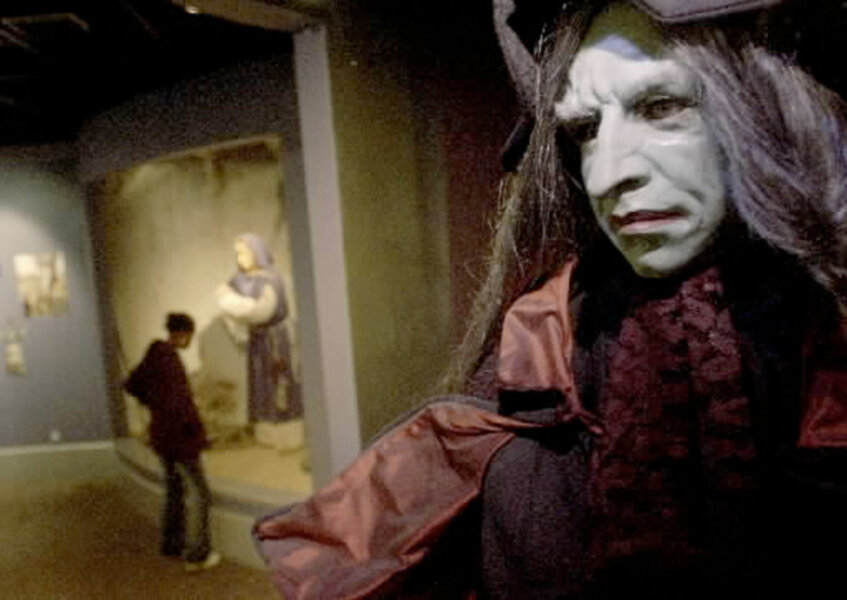Salem witch trials: the original 'Halloween witch' scare
Loading...
As we prepare to scare ourselves silly this Halloween with haunted houses and horror-movie marathons, one theme will be as popular as ever: The outsider who lurks within, unseen until it's too late.
Aliens who look just like us, perhaps. A maniac who's calling from inside the house. A mysterious mother who "isn't quite herself today."
It's scary stuff, especially when it's based on the horrors and tragedies of real life. But there's another side, one explored by writers like Arthur Miller and Rod Serling: What happens when fear and hysteria turn neighbor against neighbor, loved one against loved one?
The Salem Witch Trials of 1692 offer insight into the price of paranoia, but their lessons can get lost amid pop culture's fascination with witchcraft. On TV alone, they've served as a foundation for both the light comedy of "Bewitched" (a statue of the Samantha character stands in Salem) and the deeply dark themes of the gothic new TV show "American Horror Story: Coven."
Historian Marilynne K. Roach, a lifelong resident of nearby Watertown, is a leading Salem witch trial expert. She offers a unique take on the tragedy by combining fictional recreations and historical facts in her new book "Six Women of Salem: The Untold Story of the Accused and Their Accusers in the Salem Witch Trials."
In an interview, Roach punctured some myths, identified some heroes and explained how the leaders of Salem ultimately redeemed themselves, at least to a point.
Q: Why this place and this time? What factors came together to make the Salem witch trials happen?
A: Somebody has called it a perfect storm, a terrible combination of a whole lot of things happening at once.
There's a war, and French Canadians and Native Americans are attacking the frontier towns, making people flee to Salem and Boston away from the edges of the frontier. The economy isn't great because there's a war on. There were stresses from smallpox, the Massachusetts government had lost its charter, and there were problems in the leadership of the church. And there were probably a whole lot of personality conflicts and private disputes.
Q: How did it all begin?
A: In the household of the minister, his daughter and niece seem to be ill. At first, people thought it was something natural, and the parents treated it as an illness. They tried home remedies, and they prayed for them.
Then they called in local physicians, one of whom says they may be under an evil hand, an evil spell.
That's when people start wondering who rather than what is wrong with them.
Q: How did fingers start to be pointed?
A: A slave named Tituba was arrested along with two other women and Tituba was backed into a confession. They don't believe anything she says about her innocence, so she starts to make up what they want to hear to make it stop, that she had a vision of people's names in a book. But she couldn't read them because she was illiterate.
Everybody starts wondering which of their neighbors might be one of those people who's in the devil's book and started filling in the blanks. Anyone who had a grudge or suspected someone or just didn't like them would remember when it seemed like they were up to no good.
Q: Are there myths today about what happened in Salem?
The people who were accused were not practicing witches, they weren't pagans or neo-pagans, and they certainly weren't fairy-tale witch characters. Altogether, 19 people were hanged, including two of the six in the book. It was no Halloween joke.
Q: Are there any heroes in this story?
A: It gets forgotten, but there were opposing voices, and people did speak up. For example, the family of an accused woman named Rebecca Nurse stood by her and got testimony in her favor. They had neighbors sign a petition saying she was a good person and not in league with the devil.
At least 250 names are signed to all of these kinds of petitions put together, and a few other people made depositions and statements to the good character of the accused. Their voices weren't heard well enough, but they persisted.
Q: How did the trials finally come to an end?
A: They eventually came to their senses.
They didn't stop believing that the spiritual world was possible. But they came to the conclusion that they weren't interpreting this carefully enough, that they couldn't trust the evidence.
The government essentially apologized, and there was a public fast in 1697 to acknowledge that things had gone wrong. And there was an attempt at reparations with money in 1712 for the survivors and their families, and the names of the accused who'd been found guilty were cleared.
It was a little late, but they did take responsibility within the lifetimes of those involved. One of the reason the trials are held up as an example of human folly is because they weren't swept under the rug.
Q: What are lessons we can learn from the Salem of 1692?
A: Don't jump to conclusions: Examine the evidence or what appears to be evidence and make sure you're not mistaken. Is it what you think it is?
And understand that you have to speak up for the truth, even when it's dangerous.
Randy Dotinga is a Monitor contributor.







